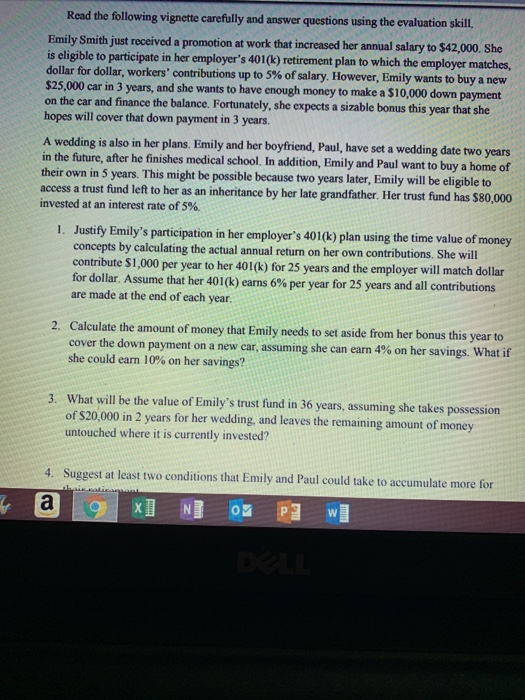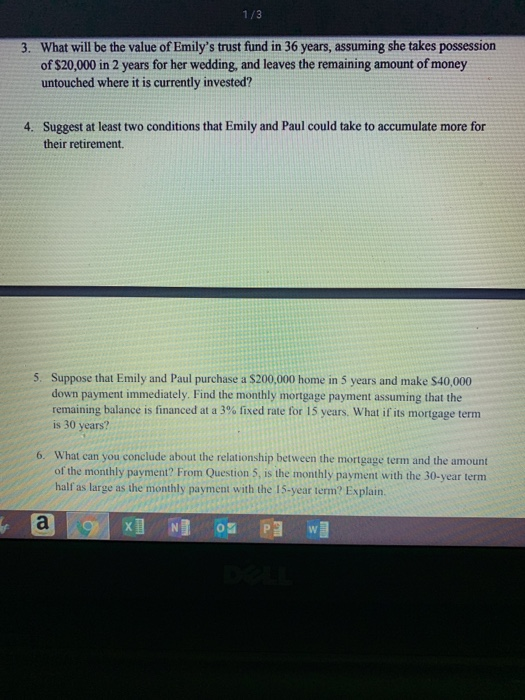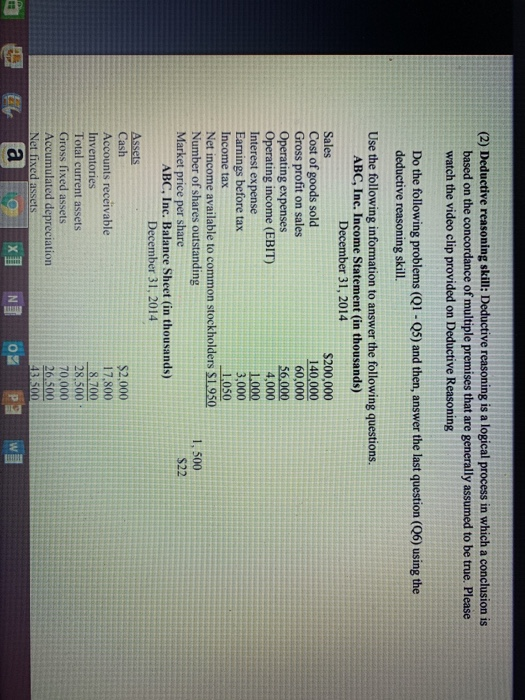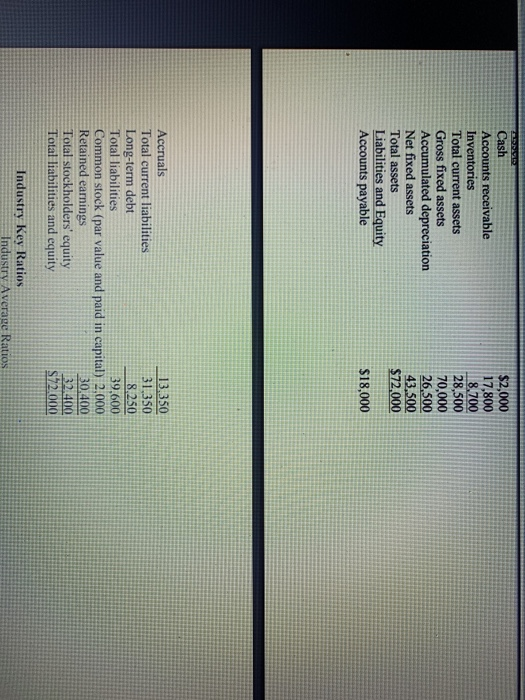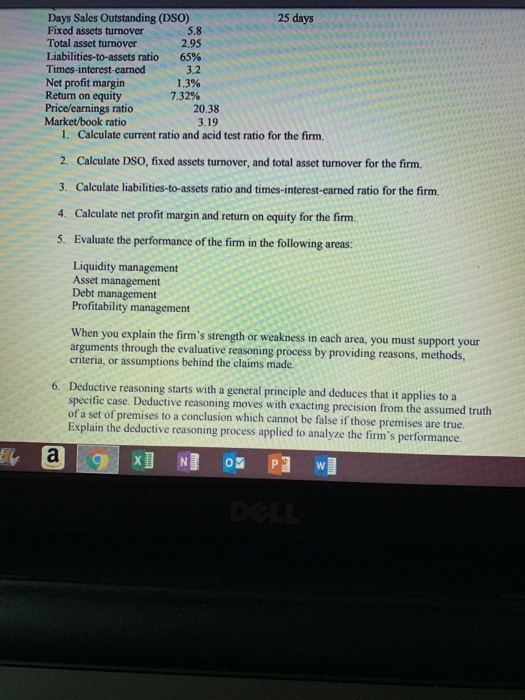Read the following vignette carefully and answer questions using the evaluation skill. Emily Smith just received a promotion at work that increased her annual salary to $42,000. She is eligible to participate in her employer's 4010k) retirement plan to which the employer matches dollar for dollar, workers' contributions up to 5% of salary. However, Emily wants to buy a new $25,000 car in 3 years, and she wants to have enough money to make a $10,000 down payment on the car and finance the balance. Fortunately, she expects a sizable bonus this year that she hopes will cover that down payment in 3 years. A wedding is also in her plans. Emily and her boyfriend, Paul, have set a wedding date two years in the future, after he finishes medical school. In addition, Emily and Paul want to buy a home of their own in 5 years. This might be possible because two years later, Emily will be eligible to access invested at an interest rate of 5%. a trust fund left to her as an inheritance by her late grandfather. Her trust fund has $80,000 Justify Emily's participation in her employer's 401(k) plan using the time value of money concepts by calculating the actual annual return on her own contributions. She will contribute $1,000 per year to her 401(k) for 25 years and the employer will match dollar for dollar. Assume that her 401(k) earns 6% per year for 25 years and all contributions are made at the end of each year. 1. Calculate the amount of money that Emily needs to set aside from her bonus this year to cover the down payment on a new car, assuming she can earn 4% on her savings, what if she could earn 10% on her savings? 2. What will be the value of Emily's trust fund in 36 years, assuming she takes possession of $20,000 in 2 years for her wedding, and leaves the remaining amount of money untouched where it is currently invested? 3. Suggest at least two conditions that Emily and Paul could take to accumulate more for 4. 1/3 What will be the value of Emily's trust fund in 36 years, assuming she takes possession of $20,000 in 2 years for her wedding, and leaves the remaining amount of money untouched where it is currently invested? 3. Suggest at least two conditions that Emily and Paul could take to accumulate more for their retirement. 4. 5. Suppose that Emily and Paul purchase a $200,000 home in 5 years and make $40,000 down payment immediately. Find the monthly mortgage payment assuming that the remaining balance is financed at a 3% fixed rate for 15 years, what if its mortgage term is 30 years? What can you conclude about the relationship between the mortgage term and the amount of the monthly payment? From Question 5, is the monthly payment with the 30-year term half as large as the monthly payment with the 15-year term? Explain. 6. (2) Deductive reasoning skill: Deductive reasoning is a logical process in which a conclusion is based on the concordance of multiple premises that are generally assumed to be true. Please watch the video clip provided on Deductive Reasoning Do the following problems (Q1-Q5) and then, answer the last question (Q6) using the deductive reasoning skill. Use the following information to answer the following questions. ABC, Inc. Income Statement (in thousands) December 31, 2014 $200,000 60,000 4,000 3,000 Sales Cost of goods sold Gross profit on sales Operating expenses Operating income (EBIT) Interest expense Earnings before tax Income tax Net income available to common stockholders $1.950 Number of shares outstanding Market price per share 1, 500 S22 ABC, Inc. Balance Sheet (in thousands) December 31, 2014 $2,000 17.800 Cash Accounts receivable Inventories Total current assets Gross fixed assets Accumulated depreciation 700 28,500- 70,000 43 500 $2,000 17,800 8.700 28,500 70,000 26 Cash Accounts receivable Inventories Total current assets Gross fixed assets Accumulated depreciation Net fixed assets Total assets Liabilities Accounts payable $18,000 13.350 31.350 8.250 39,600 Accruals Total current liabilities Long-term debt Total liabilities Common stock (par value and paid in capital) 2.000 Retained earnings 30.400 Total stockholders' equity 2 000 Total liabilities and equity Industry Key Ratios Industry Average Ratios 25 days Days Sales Outstanding (DSO) Fixed assets turnover Total asset turnover Liabilities-to-assets ratio 65% Times-interest-carned Net profit margin Return on equity Price/earnings ratio Market/book ratio 5.8 2.95 3.2 1.3% 7.32% 20.38 3.19 1. Calculate current ratio and acid test ratio for the firm. 2. Calculate DSO, fixed assets turnover, and total asset turnover for the firm. 3. Calculate liabilities-to-assets ratio and times-interest-earned ratio for the firm. 4. Calculate net profit margin and return on equity for the firm. 5. Evaluate the performance of the firm in the following areas: Liquidity management Asset management Debt management Profitability management When you explain the firm's strength or weakness in each area, you must support your arguments through the evaluative reasoning process by providing reasons, methods, criteria, or assumptions behind the claims made. Deductive reasoning starts with a general principle and deduces that it applies to a specific case. Deductive reasoning moves with exacting precision from the assumed truth of a set of premises to a conclusion which cannot be false if those premises are true Explain the deductive reasoning process applied to analyze the firm's performance. 6. Read the following vignette carefully and answer questions using the evaluation skill. Emily Smith just received a promotion at work that increased her annual salary to $42,000. She is eligible to participate in her employer's 4010k) retirement plan to which the employer matches dollar for dollar, workers' contributions up to 5% of salary. However, Emily wants to buy a new $25,000 car in 3 years, and she wants to have enough money to make a $10,000 down payment on the car and finance the balance. Fortunately, she expects a sizable bonus this year that she hopes will cover that down payment in 3 years. A wedding is also in her plans. Emily and her boyfriend, Paul, have set a wedding date two years in the future, after he finishes medical school. In addition, Emily and Paul want to buy a home of their own in 5 years. This might be possible because two years later, Emily will be eligible to access invested at an interest rate of 5%. a trust fund left to her as an inheritance by her late grandfather. Her trust fund has $80,000 Justify Emily's participation in her employer's 401(k) plan using the time value of money concepts by calculating the actual annual return on her own contributions. She will contribute $1,000 per year to her 401(k) for 25 years and the employer will match dollar for dollar. Assume that her 401(k) earns 6% per year for 25 years and all contributions are made at the end of each year. 1. Calculate the amount of money that Emily needs to set aside from her bonus this year to cover the down payment on a new car, assuming she can earn 4% on her savings, what if she could earn 10% on her savings? 2. What will be the value of Emily's trust fund in 36 years, assuming she takes possession of $20,000 in 2 years for her wedding, and leaves the remaining amount of money untouched where it is currently invested? 3. Suggest at least two conditions that Emily and Paul could take to accumulate more for 4. 1/3 What will be the value of Emily's trust fund in 36 years, assuming she takes possession of $20,000 in 2 years for her wedding, and leaves the remaining amount of money untouched where it is currently invested? 3. Suggest at least two conditions that Emily and Paul could take to accumulate more for their retirement. 4. 5. Suppose that Emily and Paul purchase a $200,000 home in 5 years and make $40,000 down payment immediately. Find the monthly mortgage payment assuming that the remaining balance is financed at a 3% fixed rate for 15 years, what if its mortgage term is 30 years? What can you conclude about the relationship between the mortgage term and the amount of the monthly payment? From Question 5, is the monthly payment with the 30-year term half as large as the monthly payment with the 15-year term? Explain. 6. (2) Deductive reasoning skill: Deductive reasoning is a logical process in which a conclusion is based on the concordance of multiple premises that are generally assumed to be true. Please watch the video clip provided on Deductive Reasoning Do the following problems (Q1-Q5) and then, answer the last question (Q6) using the deductive reasoning skill. Use the following information to answer the following questions. ABC, Inc. Income Statement (in thousands) December 31, 2014 $200,000 60,000 4,000 3,000 Sales Cost of goods sold Gross profit on sales Operating expenses Operating income (EBIT) Interest expense Earnings before tax Income tax Net income available to common stockholders $1.950 Number of shares outstanding Market price per share 1, 500 S22 ABC, Inc. Balance Sheet (in thousands) December 31, 2014 $2,000 17.800 Cash Accounts receivable Inventories Total current assets Gross fixed assets Accumulated depreciation 700 28,500- 70,000 43 500 $2,000 17,800 8.700 28,500 70,000 26 Cash Accounts receivable Inventories Total current assets Gross fixed assets Accumulated depreciation Net fixed assets Total assets Liabilities Accounts payable $18,000 13.350 31.350 8.250 39,600 Accruals Total current liabilities Long-term debt Total liabilities Common stock (par value and paid in capital) 2.000 Retained earnings 30.400 Total stockholders' equity 2 000 Total liabilities and equity Industry Key Ratios Industry Average Ratios 25 days Days Sales Outstanding (DSO) Fixed assets turnover Total asset turnover Liabilities-to-assets ratio 65% Times-interest-carned Net profit margin Return on equity Price/earnings ratio Market/book ratio 5.8 2.95 3.2 1.3% 7.32% 20.38 3.19 1. Calculate current ratio and acid test ratio for the firm. 2. Calculate DSO, fixed assets turnover, and total asset turnover for the firm. 3. Calculate liabilities-to-assets ratio and times-interest-earned ratio for the firm. 4. Calculate net profit margin and return on equity for the firm. 5. Evaluate the performance of the firm in the following areas: Liquidity management Asset management Debt management Profitability management When you explain the firm's strength or weakness in each area, you must support your arguments through the evaluative reasoning process by providing reasons, methods, criteria, or assumptions behind the claims made. Deductive reasoning starts with a general principle and deduces that it applies to a specific case. Deductive reasoning moves with exacting precision from the assumed truth of a set of premises to a conclusion which cannot be false if those premises are true Explain the deductive reasoning process applied to analyze the firm's performance. 6
